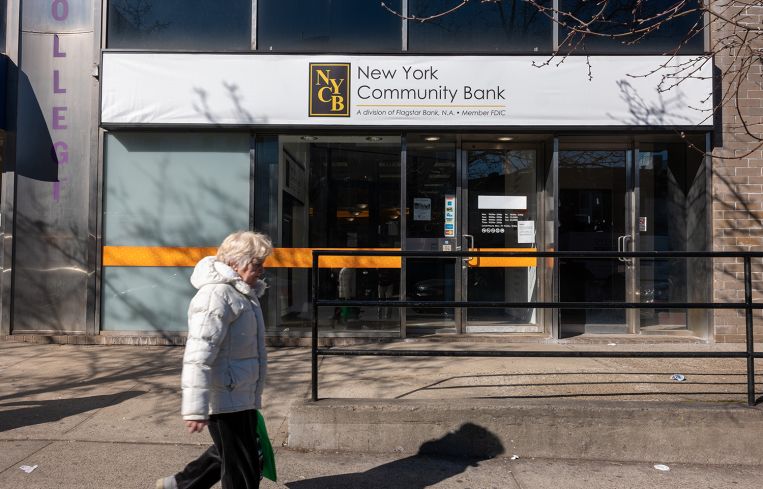As NYCB Teeters, Private Lenders Corner CRE Lending Market
By Andrew Coen February 9, 2024 7:00 am
reprints
As New York Community Bank (NYCB) grapples with big hits to its stock price after reporting pressures on its commercial real estate loan portfolio, market participants have fears that more hits to the regional banking universe could exacerbate tighter lending conditions.
NYCB’s fourth-quarter earnings release showed a provision for credit losses of $552 million, with much of those reserves tied to CRE debt. The distress caused Moody’s Investors Service to downgrade NYCB’s credit rating to junk level citing “financial, risk-management and governance challenges.”
The bank’s struggles come after the March 2023 failures of Silicon Valley Bank and Signature Bank. After those banks collapsed, NYCB saw an opportunity and picked up Signature’s assets in a $2.7 billion deal, but that also helped the bank surpass $100 billion in assets and helped cause its current woes.
“New York Community Bank is the first real estate-related problem that has surfaced for banks in a meaningful way,” said Stuart Boesky, the CEO of private lender Pembrook Capital Management. “Also, once you hit the $100 billion mark, you have more capital requirements and they are no longer able to kick the can down the road.”
With the regional banking sector already shaky, some lenders say NYCB’s issues could add pressure to a vital part of the lending industry that’s already strained — particularly regional banks with large commercial real estate exposure on their books.
“The regional banks are going to struggle through this period of time, and those that are smaller and have higher exposure [to CRE] as a part of their total assets are going to have a need for some backstop to handle solvency issues,” said Alan Purser, global head of capital formation for multifamily construction lender S3 Capital. “We certainly don’t want to go down a path where depositors have concerns about the safety of their money in these financial organizations.”
That might be bad news for regional banks — which stepped up to fill the void in CRE lending when money center banks moved to the sidelines in 2022 — but it could be good news for private lenders, which have picked up much of the slack as banks retreated.
Purser said regional banks used to be a major competitor, but the increased burdens on smaller banks holding CRE loans have generated more business opportunities for him and other private lenders, even with a spike in borrowing costs over the last two years.
The potential new troubles facing the regional banking sector could create new barriers for CRE lending. Boesky said that private lenders, already an active force in the lending landscape these past 18 months, will be counted on more than ever to help fill the void in 2024. Boesky expects many of the 2024 CRE loans he’ll vie for to take flight in the form of short-term bridge loans with equity partners.
“The deals that are going to get done this year and next year are really largely going to be what I would refer to as rescue capital,” Boesky said. “You’re basically going to fill a gap in the capital stack that the current market has created.”
And there could be opportunities as well for private lenders to capitalize on NYCB’s struggles. NYCB Executive Chairman Alessandro “Sandro” DiNello said during an investor call Wednesday that the bank wants to reduce its CRE concentration “as quickly as we can,” which could include loan sales.
He also stressed that overall deposits are up from year-end 2023 and remained “resilient” along with its liquidity levels, despite market headwinds. Still, the less-than-stellar earnings report caused its shares to drop more than 50 percent since it reported a quarterly loss of $252 million on Jan. 31.
The bank’s CRE risks are now under much more investor scrutiny since it grew past $100 billion in assets and Moody’s, in its downgrade announcement, noted that NYCB’s credit challenges are largely attributed to the bank’s “significant concentration’ in low fixed-rate multifamily loans, with many of them tied to rent-regulated properties, not unlike Signature Bank.
While last year’s bank failures triggered a wider regional banking crisis that resulted in fewer players in the CRE lending space, both SVB and Signature’s woes were caused by non-real estate issues. NYCB’s credit challenges differ in that they are directly related to commercial real estate, an industry that has faced plenty of distress in recent months.
Since plenty of other regional banks carry plenty of CRE loans on their balance sheets, NYCB might not be the last of those banks to face challenges this year.
“This situation is a little peculiar to New York Community Bank, but that doesn’t mean there aren’t going to be other problems,” Boesky said. “It is capital markets driven to a very large extent.”
Andrew Coen can be reached at acoen@commercialobserver.com.



